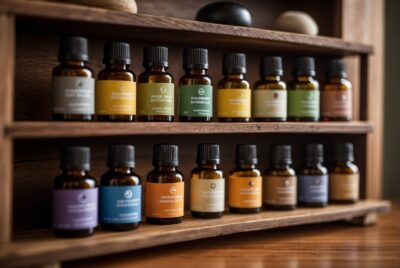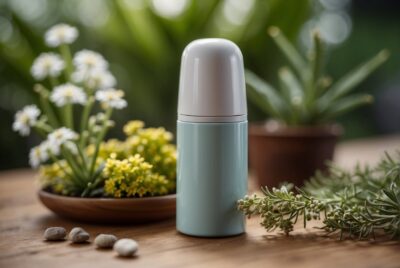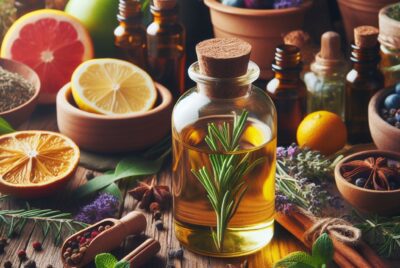Vanilla Essential Oil Benefits: Unveiling Its Holistic Uses
*We may earn a commission for purchases made using our links. Please see our disclosure to learn more.
Vanilla Essential Oil Benefits: Unveiling Its Holistic Uses
Vanilla essential oil, extracted from the vanilla bean, is renowned for its sweet, soothing aroma. I find this essential oil to be an incredibly versatile addition to my daily routine, imparting its rich scent throughout my home when used in a diffuser. The oil’s popularity in aromatherapy is well-deserved, as its comforting fragrance can help relax the mind and alleviate stress.

The applications of vanilla essential oil extend beyond its tranquil scent. In my experience, it’s been useful for enhancing mood and providing a sense of comfort and warmth. When used in personal care products, such as lotions or bath oils, it adds a luxurious note to the experience, and I’ve also come across suggestions for its use in homemade perfumes and body care recipes.
Moreover, vanilla essential oil is employed in a range of other practices. I’ve learned of its use in skin care routines where it’s believed to have beneficial properties, and it’s also found its place in hair care solutions, contributing to a silky, fragrant finish. In each use, it’s important to recognize the quality of the essential oil and ensure it’s properly diluted when being used topically, as I always prioritize safety along with enjoyment of its many benefits.
Origins and Extraction of Vanilla Essential Oil

In exploring the enchanting world of Vanilla Essential Oil, I will unveil its origins from the delicate vanilla plant and the meticulous extraction methods employed to harness its aromatic essence.
Vanilla Plant and Bean Pods
The vanilla used in essential oils comes from the Vanilla planifolia, an orchid species native to Mexico. Vanilla plants produce pods commonly referred to as vanilla beans, which undergo an extensive post-harvest process. Once harvested, the beans endure a labor-intensive process including drying and curing, which may last for several months to develop their full aromatic profile.
Extraction Process
To obtain Vanilla Essential Oil, a method known as solvent extraction is utilized. During this process, a natural solvent permeates the vanilla beans to extract the aromatic compounds. Following the solvent’s removal, a potent concentrate known as vanilla absolute remains. Although this absolute resembles an essential oil, it’s much thicker and more viscous due to the rich and creamy essence of vanilla.
Aromatherapy and Therapeutic Uses

In my examination of vanilla essential oil, I’ve found it widely recognized for its calming properties and various health benefits, particularly when used in aromatherapy.
Calming and Relaxation
I’ve discovered that diffusing vanilla essential oil is an effective way to promote a sense of calm and relaxation. When I diffuse this oil, its soothing aroma helps to:
- Alleviate stress: The scent works as a natural relaxant, which assists in reducing stress and anxiety levels.
- Enhance mood: The pleasant fragrance of vanilla can act as a mild antidepressant, uplifting the spirit.
- Improve sleep: Through its relaxing properties, it encourages better sleep quality.
Health Benefits
Vanilla essential oil has shown health benefits when used in aromatherapy. I consider these benefits to be significant for overall well-being:
- Antioxidant protection: It contains antioxidants, which combat free radicals and may prevent oxidative stress.
- Aphrodisiac effects: Historically, vanilla is believed to enhance libido and potentially aid in relieving symptoms of erectile dysfunction.
- Mental health support: As an antidepressant, it may contribute positively to mental health care, fostering feelings of joy and tranquility.
The therapeutic uses of this essential oil are grounded in its inherently soothing quality and its subtle influence on the mind and body.
Vanilla Essential Oil in Skincare

In my experience with natural skincare, vanilla essential oil has been recognized for its rich antioxidant and anti-inflammatory properties. I’ve found that its beneficial components can significantly enhance skin health when incorporated properly into skincare routines.
Moisturizing and Anti-Inflammatory of Vanilla Essential Oil
Moisturizing Benefits:
- Natural Emollients: it contains compounds that help moisturize and hydrate the skin. This is crucial for individuals with dry or dehydrated skin.
- Antioxidant Properties: Rich in antioxidants, it helps combat free radical damage that could otherwise lead to premature aging.
Anti-Inflammatory Properties:
- Soothing Irritations: The anti-inflammatory effects are key in calming skin inflammation and irritation.
- Bacterial Skin Ailments: As an antibacterial agent, it may aid in treating bacterial conditions like acne.
Blends and DIY Care
Blending with Carrier Oils:
- Facial Serums: For a hydrating facial serum, I blend a few drops of vanilla essential oil with jojoba oil, as jojoba closely mimics the skin’s natural oils.
- Essential Oil Synergy: Vanilla blends well with oils like lavender and sandalwood, creating soothing and aromatic skincare formulas.
Do-It-Yourself Skincare:
- Homemade Recipes: I often use it in homemade balms and creams for its scent and skin benefits.
- Customization: One can customize their own skincare treatments by adding vanilla essential oil to suit specific skin needs.
Culinary and Home Uses for Vanilla Essential Oil

When I consider the versatility of vanilla, two distinct applications come to mind: enhancing flavors in the kitchen and creating a welcoming atmosphere at home through its scent.
Cooking and Beverages
In my culinary experience, pure vanilla extract is an indispensable ingredient for a wide variety of recipes. It adds a rich, comforting flavor to desserts and baked goods, and a dash of vanilla can elevate the taste of chocolate or coffee. The aromatic profile of vanilla pairs exceptionally well with fruits and is often used to accentuate the sweetness in drinks and smoothies. Although many recipes call for vanilla extract, some people explore the use of vanilla oil in the culinary space, but caution is advised due to its concentrated nature.
- Desserts: Vanilla is a staple in ice cream, cakes, and pastries.
- Drinks: A drop of vanilla can add a layer of flavor to coffee, tea, and craft cocktails.
- Combinations: Vanilla complements spices like cinnamon and clove, especially in festive beverages.
Homemade Air Fresheners
I’ve found that vanilla oil can also transform a home with its warm, inviting aroma. Creating a homemade air freshener with vanilla oil is a simple and natural way to freshen up a room. A popular blend involves a few drops each of vanilla, cinnamon, and orange essential oils in distilled water, offering a natural alternative to artificial fragrances.
- Room Spray: Mix vanilla oil with water, a pinch of salt, and other essential oils to create a welcoming scent.
- Dryer Ball: Add a few drops of vanilla oil to a wool dryer ball for pleasantly scented laundry.
- Bath Salts: Infusing bath salts with vanilla oil can turn a regular bath into a luxurious spa experience.
- Sugar Scrub: Combine sugar, a carrier oil, and vanilla oil for a sweet-smelling exfoliating scrub.
Precautions and Best Practices

Before diving into the practical uses, I find it important to emphasize safety and appropriate usage to ensure a positive experience. Whether using it for aromatherapy or topical application, being informed of potential side effects and proper practices will mitigate the risk of negative reactions.
Safe Usage
- Patch Test: A patch test is a must to check for allergic reactions before using it extensively. I apply a small amount mixed with a carrier oil, such as sweet almond oil, to an inconspicuous area of skin and wait for 24 hours.
- Carrier Oils: Vanilla oil should be diluted with a carrier oil before topical application to avoid skin irritation. A ratio of 1% essential oil, which equates to about 6 drops per ounce of carrier oil, is a standard concentration for massage oils.
Possible Adverse Reactions
- Allergies and Side Effects: Despite its pleasant aroma, vanilla essential oil can cause side effects if misused. Signs of an allergic reaction may include redness, itching, or rash. In such cases, I cease use immediately and seek medical advice.
- Topical Application: It’s important to use vanilla essential oil responsibly when applying it to the skin. Overuse can lead to sensitization or adverse reactions, so I always adhere to recommended dilutions and usage guidelines.
Frequently Asked Questions about Vanilla Essential Oil
In this section, I address some of the most common inquiries surrounding vanilla essential oil, focusing on its benefits for skin and hair, its uses in aromatherapy and perfumery, and important considerations for its safe application.
1. What are the skin benefits of using vanilla essential oil?
Vanilla essential oil is celebrated for its skin benefits, which include soothing properties that can help calm irritation and promote a clear complexion. Its antioxidant content may also aid in protecting the skin from environmental stressors.
2. How can it contribute to hair health?
When used in hair care, vanilla essential oil can help impart a natural shine and pleasant fragrance. Its moisturizing properties may also assist in reducing hair breakage and improving overall scalp health when used with a carrier oil.
3. What are the uses of vanilla essential oil in aromatherapy?
In aromatherapy, it is primarily used for its calming effect, which can help alleviate stress and promote relaxation. The warm, comforting aroma is also believed to enhance mood and mental clarity.
4. In what ways is it included in perfumery?
It is a popular ingredient in perfumery due to its rich, warm scent that serves as a base note. It adds depth to fragrances and is often blended with other notes to create complex and inviting bouquets.
5. Can it be applied topically without a carrier oil?
It is not recommended to apply it directly onto the skin without diluting it in a carrier oil. Undiluted essential oils can be potent and may cause skin irritation or sensitivity for some individuals.




